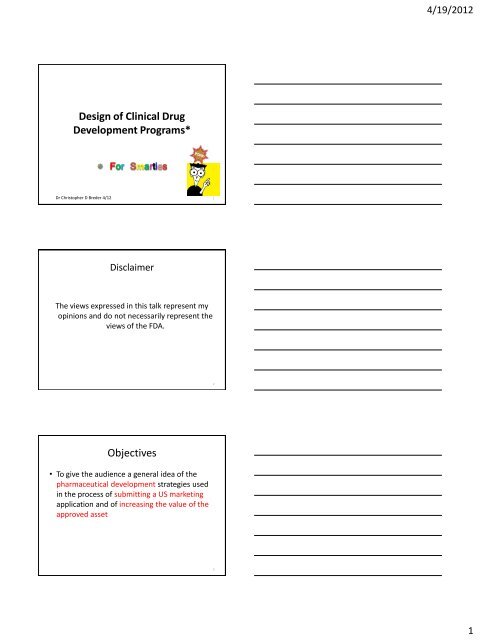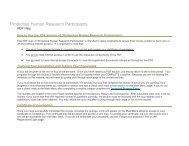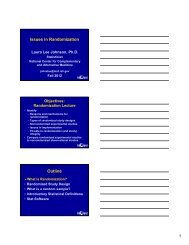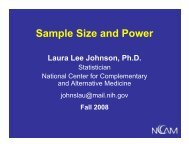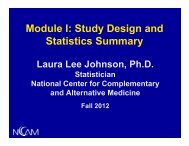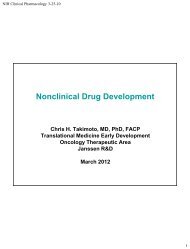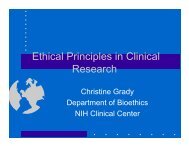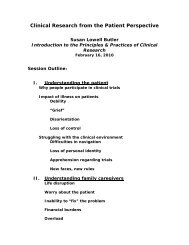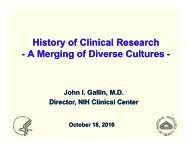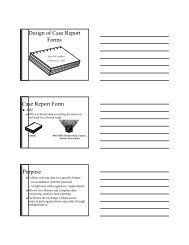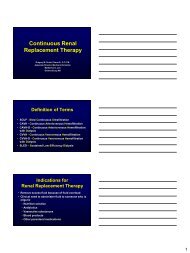Design of Clinical Drug Development Programs*
Design of Clinical Drug Development Programs*
Design of Clinical Drug Development Programs*
- No tags were found...
Create successful ePaper yourself
Turn your PDF publications into a flip-book with our unique Google optimized e-Paper software.
4/19/2012<strong>Design</strong> <strong>of</strong> <strong>Clinical</strong> <strong>Drug</strong><strong>Development</strong> <strong>Programs*</strong>* For SmartiesDr Christopher D Breder 4/12 1DisclaimerThe views expressed in this talk represent myopinions and do not necessarily represent theviews <strong>of</strong> the FDA.2Objectives• To give the audience a general idea <strong>of</strong> thepharmaceutical development strategies usedin the process <strong>of</strong> submitting a US marketingapplication and <strong>of</strong> increasing the value <strong>of</strong> theapproved asset31
4/19/2012Where do New <strong>Drug</strong> Products come From?4<strong>Development</strong> Lead Selection.1New Molecular or ChemicalEntities *Chemical SynthesisStructure Activity Relationships“Fishing”Fortuitous FindsEtc…BiologicsAntibodiesOligonucleotidesEnzymesReplacement proteinsEtc…ReformulationsFormulation +Modified Release includingControlled andExtended releaseEtc…High Throughput Screening5* A drug where no active moiety has been approved through Sec.505(b) <strong>of</strong> the FD&CA<strong>Development</strong> Lead Selection.24 ChemicalCandidates, A, B, C & DOral (+/- SQ, IN?) Bioavail.B = ++++, C= +, D= +++Receptor BindingA = 23 nM; B=45 nM; C=67 nM;D=120 nMIn Vivo PD ScreenB = +++, C= ++, D= ++++Off target < 500nMA = 5HT2B Ag; B = M1; C = MuAg; D=CCKAPreliminary toxB ~ DCExtras…ADME, PgP, etcB “-”; D= CYP3A4 inh, PgP subs.DB goes to “IND enabling” program; SARfocus on B like molecules62
4/19/2012Conclusion 1. Efficacy Requirements• So, unless you have contributory evidence,you should plan on doing two adequate andwell controlled trials (AWCT).– “Phase 3”, “Pivotal”, “Registrational”, or“Confirmatory”• Exceptions?Coming soon….How to get to your 2 adequate and well controlled Phase 3trials.13Patient / Metabolism Specific Studies• Some studies you should do prior to Phase 3– Renal or Hepatic Impairment PK (RIPk or HIPk)• Depending on the metabolism, population• The results may effect whether you include this population or doseadjust in Phase 3– <strong>Drug</strong> <strong>Drug</strong> Interaction Studies (DDI)• Depending on the In Vitro Metabolic Pr<strong>of</strong>ile• The results may effect whether you include this population or doseadjust in Phase 3• Very <strong>of</strong>ten these subjects are excluded from Phase 2because these studies have not been performed.– Usually dose not effect your overall dose / efficacy.safetyexploration• Often want to determine if drug efficacious before investing inthese studies14<strong>Clinical</strong> <strong>Development</strong> Path ….so far2 AWCTPh3NDARIPkHIPkDDIData from these studies obtained prior to Ph3 155
4/19/2012How do I get to my 2 AWCT• What do I need to know to conduct theseAWCTs?– Right dose in terms <strong>of</strong> efficacy and safety, from…• Phase 2b trials – effect <strong>of</strong> dose range on efficacy andsafety16Phase 2, the Lone Unloved<strong>Development</strong> Phase• Not strictly required by regulations– However, a case may be made for the safeconduct <strong>of</strong> Phase 3 based on thoroughunderstanding <strong>of</strong> the dose / efficacy orsafetyrelationship– E.g., for drugs with toxicities, may want toensure the lowest efficacious dose is used.• These trials are almost as long and expensive in certaindesigns as the Phase 3 studies– Can they be used as registrational?• In certain cases, you can make argument for not doing17– Modified release formulations with well behaved PKAim <strong>of</strong> <strong>Drug</strong> <strong>Development</strong>• CMC [21 CFR 312.23(a)(7)]:To assure the proper identification, quality, purity,and strength <strong>of</strong> the investigational drug.• Nonclinical [21 CFR 312.23(a)(8)]:To assure that it is reasonably safe to conduct theproposed clinical investigations.• <strong>Clinical</strong> [FD&C Act Sec. 505]:To establish efficacy and safety <strong>of</strong> a drug for use inhumans, in a dose range and schedule thatprovides an acceptable risk benefit relationship.186
4/19/2012Dose Response Rationale19Phase 2: The Dose Response• The most typically accepted study design isthe parallel fixed-dose study• What you should know about your doserange– The “maximum tolerated dose”– The minimum efficacious dose (MED) thatgives a significant effect– The shape <strong>of</strong> the curve leading up to the MED– The effect <strong>of</strong> titration on the drugs tolerability20<strong>Clinical</strong> <strong>Development</strong> Path ….so farPhase2b2 AWCTPh3NDARIPkHIPkDDIData from these studies obtained prior to Ph3 217
4/19/2012<strong>Clinical</strong> Pharmacology Trials Before Phase2• Multiple Ascending Dose Study (MAD)– Prerequisites: SAD, Nonclinical repeat dose studies <strong>of</strong>appropriate duration and population (as applicable)– What it gives you• Maximal Tolerated Dose ~ top clinical dose• Tolerability/Safety data at or > clinical doses• Critical PK data – Cmin, accumulation etc.– Allows:• Dose selection for Phase 2,• Studies where you need to know the top clinical dose (e.g.,QT study, Food Effect study)25Multiple Ascending Dose Study• Objective: What is PK andtolerability when drug isdosed repeatedly as plannedonce marketed (MAD)?– Start dosing below anticipateddose; go to maximal tolerateddose– Informs you <strong>of</strong> tolerability,safety and steady state PK– Plan on 2 quarters from FPFV totopline data– Precedes Phase 2Multiple Dose (MD) PK Curve(open circle line)26<strong>Clinical</strong> <strong>Development</strong> Path ….so farSADMADPhase2b2 AWCTPh3NDARIPkHIPkDDIData from these studies obtained prior to Ph3 279
4/19/2012Other Supportive <strong>Clinical</strong>Pharmacology Studies• Thorough QT• Food Effect• Dose Linearity• Dose Proportionality• Mass Balance28Thorough QT Study (TQT)• A thorough QT study is performed to determinepotential <strong>of</strong> drug to prolong the QT interval <strong>of</strong> EKG.– This effect has been linked toa ventricular arrhythmia,Torsades de Pointes, which maylead to sudden cardiac death.– The study is done with the new drug, a placebo and apositive control known to induce QT prolongation– Primary endpoint: Upper bound <strong>of</strong> 90% confidence intervalin the change from baseline <strong>of</strong> a time series <strong>of</strong> EKGscannot include 10 mstorsades de pointes29Food-Effect Study• Objective – Determine effect <strong>of</strong> food(high fat meal) on drug absorption–A crossover study <strong>of</strong> fedvs fasted state–Primary endpoint - Thisis a bioequivalence study(Exposure in the fastedstate should be BE tothat in the fed state)• If not BE, labeling orreformulation dependinghttp://www.medicineonline.com/drugs/S/3503/SKELAXIN-Metaxalone-Tablets.htmlon circumstancesBE = bioequivalent or bioequivalence depending on the context3010
4/19/2012Timing Considerations <strong>of</strong> <strong>Clinical</strong>Pharmacology Studies• Thorough QT– <strong>of</strong>ten done after efficacy determined unless there is aprior signal <strong>of</strong> concern• hERG assay; CV safety pharmacology study, Ph1 EKG• Food Effect– Optimally precedes Ph2; trials prior done fasted– May consider doing a pilot study <strong>of</strong> one or twosubjects fed in early studies (SAD or SD in modifiedreleaseprogram) to check for gross food effects thatwould make one consider reformulatingDose Linearity• Objective – Linearity <strong>of</strong> dosing through theproposed clinical dose range– Ensure plasma levels increase linearly as doseincreases• Primary endpoint:xaction button<strong>Drug</strong>s Today 2000, 36(1): 55 Lornoxicam, a new potent NSAID with animproved tolerability pr<strong>of</strong>ile Radh<strong>of</strong>er-Welte, S., Rabasseda, X.32Dose Proportionality• Objective – Proportionality <strong>of</strong> Dosing Units– E.g., compare 4x1 mg, 2x2mg and 1x4 mg– Needs to know from Ph-2 studies, what doserangeto be investigated in Ph-3 and how toescalate dosing (titration to higher doses); this willdetermine what dosage units are needed.• If one uses multiple tablets to make up a certain dose(your top clinical dose is greater than your top dosagestrength) , then this study should be done prior to Ph-2A.action button3311
4/19/2012Metabolism Studies• Objective – nonclinical metabolism in vivo– track metabolites in all PK studies oncemetabolites established• Objective in clinical Mass balance study– Characterize excretion– Same mass balance experiment as inanimals …but no cage– Only way to know what metabolites are formed inman and have measureable exposure — microsomesand hepatocytes don’t fully inform with respect tothis.– Essential for downstream studies34Timing <strong>of</strong> Other <strong>Clinical</strong> Pharm Studies.2• Mass Balance– "as early as possible"– Many advocate this study should be the 3rd study conducted(after FIH and MAD study). Due to improvements in analyticalcapabilities, this study is now usually done much later in thedevelopment program. Today, plasma and urine samples fromFIH can be analyzed for metabolites without 14C material asthey can utilize the mass spectrometer to scan for potentialmetabolites. However, it is important to confirm findings oncethe compound is worthy <strong>of</strong> Phase 3 development.• Dose Linearity– Before Phase 2A, you should have an idea <strong>of</strong> this information.• Dose Proportionality– Pivotal study with to be marketed formulation before Phase 35 3Distribution in Body and to its “Target” Organ• Objective: How is the drug distributed afteradministration?–Nonclinical• Tissue levels• Whole bodyAutoradiography–<strong>Clinical</strong>• Positron Emission Tomography• Tissue fluid levels3612
4/19/2012<strong>Clinical</strong> <strong>Development</strong> Path ….so farTQT *DL DPDDISAD(DLpreliminary)MADPhase2b2 AWCTPh3NDAMBRIPkHIPkDDIData from these studies obtained prior to Ph337Aim <strong>of</strong> <strong>Drug</strong> <strong>Development</strong>• CMC [21 CFR 312.23(a)(7)]:To assure the proper identification, quality, purity,and strength <strong>of</strong> the investigational drug.• Nonclinical [21 CFR 312.23(a)(8)]:To assure that it is reasonably safe to conduct theproposed clinical investigations.• <strong>Clinical</strong> [FD&C Act Sec. 505]:To establish efficacy and safety <strong>of</strong> a drug for use inhumans, in a dose range and schedule thatprovides an acceptable risk benefit relationship.38What is Ultimately Required for Safety• Number treated for 6 months at intended clinical dosesshould be adequate to characterize the pattern <strong>of</strong> ADEs overtime. Usually 300 to 600 patients adequate;• Some patients should be treated with drug for 12 months.100 patients for minimum <strong>of</strong> one-year is acceptable• It is anticipated that total number treated with drug,including short-term exposure, will be about 1500.• Filing for approval usually possible based on data frompatients treated 6 months. Data on patients treated through12 months should be submitted as soon as available andprior to approval in USA. In the USA, initial submission fordrugs designated as priority drugs must include the 12month patient data.• Reasons for exceptions [i.e larger databases] existhttp://www.fda.gov/downloads/<strong>Drug</strong>s/Guidance%20ComplianceRegulatoryInformation/Guidances/ucm0730833913
4/19/2012Conclusion 2. Safety Requirements• As a first approximation, you will need at least1500 subjects exposed to drug– 300 for 6 months– 100 for 1 year• If there are any <strong>of</strong> a variety <strong>of</strong> safety concerns,these numbers could go more (# subjects) orlonger (duration <strong>of</strong> exposure)Coming soon….How to get to your adequate exposure database.40Long Term Extension Studies (LTES)• Objective:– Long term safety data, more subjects for longer• Guideline for Industry The Extent <strong>of</strong> Population Exposure to Assess <strong>Clinical</strong>Safety:http://www.fda.gov/downloads/<strong>Drug</strong>s/Guidance%20ComplianceRegulatoryInformation/Guidances/ucm073083• Allows observation <strong>of</strong> AEs that take longer or are less frequent than the durationand sample size <strong>of</strong> the RCT– Continuation <strong>of</strong> therapy from RCTs until marketing– Marketing claims – typically need controlled data (not OL)• <strong>Design</strong>– Usually open label• Allows Investigators to flexibly dose to effect or based on tolerance• Harder to characterize safety without control group– Can either be associated with a specific, blinded RCT or you can have oneLTES that “catches” subjects from multiple trials– Visits and evaluations usually less frequent than double blind (DB) RCT usedfor demonstrating efficacy41Schematic Diagram for LTESTreatmentActive, X mgEnd <strong>of</strong>DB RCTActive, Y mgActiveWXYZPlaceboExtra drug naïvesubjects recruited intothe LTES to bolstersample size= study visit• In this example, subjects are enrolled in the LTES from a preceding DBRCT or are drug naïve•At the end <strong>of</strong> the DB RCT treatment period, subjects are titrated to acommon dose. After achieving that dose, the Investigator is allowed t<strong>of</strong>lexibly change their dose level throughout the trial, to a dose that isusually between a subjects minimally effective (Z) and maximally tolerated(W) dose.•Various rules are applied as to the common dose, the frequency <strong>of</strong> dosechanges, the speed <strong>of</strong> titration and the minimum and maximum allowabledose. Note the study visits are less frequent.4214
4/19/2012<strong>Clinical</strong> <strong>Development</strong> PathTQT *DL DPDDISAD(DLpreliminary)MADPhase2b2AWCT.......Ph3OLES............. NDAMBRIPkHIPkDDIData from these studies obtained prior to Ph34344Extended Release (ER) versus Immediate Release(IR) Plasma Pr<strong>of</strong>iles4515
4/19/2012How does the <strong>Development</strong> Program For a ModifiedRelease Differ from An Immediate Release• Generally, if the excipients are Generally Recognized as Safe(GRAS) and the PK levels, are lower than the IR, you don’t needmore toxicology studies– Exceptions exist, e.g., reformulating drugs approved long ago• The dose range <strong>of</strong> the MR should be very close to the IR – IRdosing levels are usually used for planning Phase 3 trials (hencePh 2 not usual)• The goal in the tolerability comparison is <strong>of</strong>ten to showcomparison to the IR more so than Pbo.• The number <strong>of</strong> Phase 3 trials can be less than 2 since youalready have evidence the active ingredient works. The Phase 3trial must show the formulation has not rendered the moleculeineffective.46MR Clin Pharm Program AttributesStudy Objective DosingAlcoholdumpingTest for alcohol dumping in reactionvessel; May need human studydepending on resultsSDFPFV-Topline1Q eachSD Test a # formulations vs IR; Pilot fed arm SD, X-over 1 QMDRelativeBioavailabilityDose proportionalityDose linearityTest top 1-2 candidates vs IR; Finalcandidate choiceTop clinical dose MR vs IR; Gives goodpicture <strong>of</strong> tolerability; May add PboAs per IRAs per IRSteady State,X-overSteady State,X-overSD, X-overSD, X-over2Q+3-4Q1 Q1 QFood EffectAs per IRSD, X-over1 QBridgingGMPDetect changes in performance withscaleup; As per IRSD, X-over1 Q47Prototypic <strong>Clinical</strong> <strong>Development</strong> Plan(Modified Release Type)YearStudy2010 2011 2012 2013 2014 2015Pilot SD (wpilot Fed arm)Pilot MDINDRel BADose PropDose LinFood EffectBridge APIPeds PKPh3aNDALaunch4816
4/19/2012Logical Studies Flow - BiologicsFIH/SAD:Based on NOEL;Often in HNV(depends oneffect)MAD: Often inHNV (dependson effect)Duration <strong>of</strong>Effect: How<strong>of</strong>ten do youneed to dose interms <strong>of</strong> EFFECTTitration: Howfast can you getthere; Can yougo higher ifslowerPhase 2 Phase 3Other Studies:TQT, <strong>Drug</strong>Interaction,Specialpopulations,etcHNV: Healthy Normal Volunteer; MTD: Maximaltolerated dose ; NOEL: No Observed Effect Level; TQT:Thorough QT Study49NewIndicationsFormulations/ Follow OnGenericThe After-Life: Postmarketing <strong>Development</strong>PediatricsPartner?OTC50How Companies Plan to Counter Generics0 10 20 30 40 50 60 70Litigation Citizen's Petition PricingOTC Authorized Generic Generic SubsidiaryNew Formulations New Indications Pediatric ExclusivityNext Generation <strong>Drug</strong>Combination <strong>Drug</strong>http://www.pharmalot.com/2010/07/how-brand-name-drugmakers-fight-generics/ 5117
4/19/2012Life Cycle Management ROIDollars Earned Per $1 Spent140120100806040200Want To Milk A Cash Cow? Try Pediatric Exclusivity Pharmalot By Ed Silverman //October 7th, 2010 //52Pediatric <strong>Development</strong>• Best Pharmaceuticals for Children Act• Pediatric Research Equity ActThe Carrot and Stick <strong>of</strong> Pediatric <strong>Drug</strong> <strong>Development</strong>53• Studies mandatory• Studies required only onproduct & indicationbeing reviewed• Studies not required fororphan indications• Standard review – unlessit qualifies for priority• <strong>Drug</strong>s and biologicsPREA vs. BPCA• Studies voluntary• Studies on entire activemoiety• WR may be issued fororphan indications• Priority review• <strong>Drug</strong>s only• Both - Pediatric studies must be labeled5418
StudyDeferWaiver4/19/2012Pediatrics - 3 Flavors• Epilepsy• Asthma• Depression• Type 2Diabetes• ALS• Parkinson'sSome diseases have distinct Adult and Pediatric Indications but a pure adult programmay not be allowed if it is expected that pediatrics will be prescribed the medication 55Pediatric Programs• Nonclinical "Juvenile Tox Study (-ies)"– <strong>Design</strong>ed in conjunction with review body includingitems <strong>of</strong> special interest given drugs mechanism• <strong>Clinical</strong> Program - An example (there are manyways to do this)– Phase 2A study• Main goal is PK, tolerability leading to dose selection withPharmacodynamic secondary endpoints– Phase 3– Issues• Weight based dosing• Placebo• Ethics - Subpart D56Over-The-Counter <strong>Drug</strong>shttp://www.chpa-info.org/pressroom/Sales_Category.aspx5719
4/19/2012OTC <strong>Drug</strong> ProductsGeneral Concepts• Need to ensure that consumers can:– Diagnose the underlying condition– Determine whether drug is appropriate for them– Self-administer safely and effectively– Avoid potential serious consequences– Recognize when to see a physician or seek emergencyassistance• Label comprehension is key to approval– All labeling directed to the consumer58Generic <strong>Drug</strong>shttp://www.themedica.com/articles/2009/04/the-us-generic-drugs-industry.html59Definition <strong>of</strong> Generic <strong>Drug</strong>• “Same” as a drug product listed in the Orange Book (“listed drug”)– active ingredient(s)– route <strong>of</strong> administration– dosage form– strength– conditions <strong>of</strong> use recommended in labelingOR. . .• Certain changes from a listed drug if FDA has approved a suitabilitypetition• Labeling same as reference listed drug except for– Manufacturer/distributor– Indications protected by patent or exclusivity60– “Voluntary” pieces <strong>of</strong> approved labeling20
4/19/2012Summary• <strong>Clinical</strong> <strong>Development</strong> is the portion <strong>of</strong> the programwith an aim to provide information about the doserelationship <strong>of</strong> safety and efficacy and to provideevidence for risk benefit considerations• The <strong>Clinical</strong> Pharmacology portion is driven byspecific questions about the drug:patientinteractions• The Efficacy considerations should be directed attesting a clinically meaningful hypothesis in thetarget population• Postmarketing planning should be in parallel with theregistrational program and execution and executionshould6121


